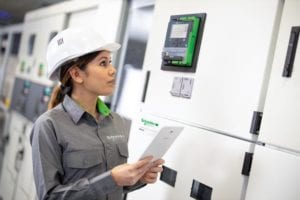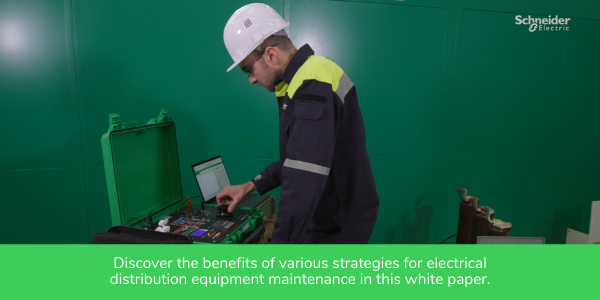An industrial organization that is not up to speed with technology modernization will be quickly left behind. Not only does modernization allow companies to better compete for a finite pool of customers, but it enables the organization’s employees to improve operational efficiency and safety. In the area of industrial plant power distribution, for example, switchgear modernization can represent up to 30% in cost savings due to decreased production downtime and reduced equipment site work costs.
Running operations on power distribution equipment that exceeds 15 years of age places the organization at risk for both catastrophic downtime and rapidly increasing maintenance costs. After 10 years, most manufacturers begin to phase out their supply of spare parts. If performance incidents occur that require parts replacement, that repair will take longer (increased mean-time-to-repair) and the parts, if they can be located, will be significantly more expensive to purchase.

But what does modernization of legacy switchgear and power distribution circuit breakers mean to plant managers besides a significant investment in order to stave off the threat of downtime and higher maintenance costs?
Over time, the implications of switchgear modernization have changed dramatically. Much like in the world of IT, the rate of technical advancement has accelerated exponentially. As a result, modernization no longer stands for wholesale replacement of the installed base of switchgear. In fact, switchgear modernization now involves major benefits in three critical areas: sustainability, asset flexibility, and digital transformation. This blog, part 1 of a series of 3, addresses the sustainability aspects of modernizing industrial switchgear plants.
Why switchgear modernization improves an organization’s sustainability
As a leading global manufacturer of switchgear and circuit breakers, Schneider Electric has over 6 million devices of switchgear-related equipment installed across customer sites across the globe. We take the responsibility of modernizing this installed base of older equipment in a way that seriously boosts sustainability. In fact, Schneider Electric today earns 70% of its revenue selling sustainable solutions, while 73% of its investments are directed toward developing newer, even more sustainable solutions.
Recently, Corporate Knights, the world’s largest circulation magazine on clean capitalism, named Schneider Electric the #1 sustainable company on their Global 100 index. We attribute much of this success to our ability to digitize our operations and then apply what we learn to create customer advantage.
Our sustainability approach to switchgear modernization rests on three important initiatives:
- Removal and safe disposal of SF6 gas – The vast majority of switchgear installed across industries today contain SF6, a greenhouse gas that acts as an insulator. Although SF6 is not harmful to humans, the gas possesses an atmospheric life span of 3,200 years and a Global Warming Potential23,500 times stronger than CO2. When switchgear approaches end-of-life, great care in either the refurbishment or disposal of the switchgear must be taken so that none of the SF6 is released into the atmosphere. Schneider Electric offers SF6 removal and disposal services to its customers and attains the proper certificates needed that prove the safe disposal of the gas.
- An emphasis on retrofit as opposed to replacement of existing gear – In a switchgear retrofit approach, Schneider Electric does all it can to preserve the base material of the existing switchgear (i.e., metal panels, cubicles, wiring) while adding in green compliant, SF6-free, replacement components. The past pattern of “rip and replace” has become obsolete in a world that counts on sustainability to maintain our planet’s collective quality of life.
- A focus on green premium replacement components – When new products are installed into existing switchgear cubicles and cabinets, Schneider Electric assures that the new components meet “green premium” Green Premium products provide detailed information regarding their regulatory compliance, material content, environmental impact, and circularity attributes. They are certified through third-party labels and product certifications that support our customers’ sustainability ambitions. They also embrace circular economy values such as durability, upgradeability, and recyclability to move beyond the “take, make, and dispose” industrial model. Those customers who choose to install Green Premium products reduce their CO2 footprint and optimize the total cost of ownership of their assets.
If the customer deems that purchasing new switchgear is their best option (e.g., when building new plants), the smart design of Schneider Electric’s new SF6-free switchgear helps them to achieve their sustainability goals. The new “air and vacuum” switchgear designs have a reduced footprint size, offer high resistance to harsh environments, and enable safety features capable of extinguishing an electric arc. The new designs maintain high levels of reliability and safety when switching power loads without a need to use SF6. In addition, the pure air insulation means that switchgear operators and technicians don’t have to learn new practices or obtain costly operating certification, increasing their efficiency and keeping them safe.

For more information
To learn more about how Schneider Electric switchgear modernization can help your organization to reduce maintenance costs while improving safety and sustainability, visit our Modernization web site. To find out how we helped ArcelorMittal with their sustainable modernization story, click here.


